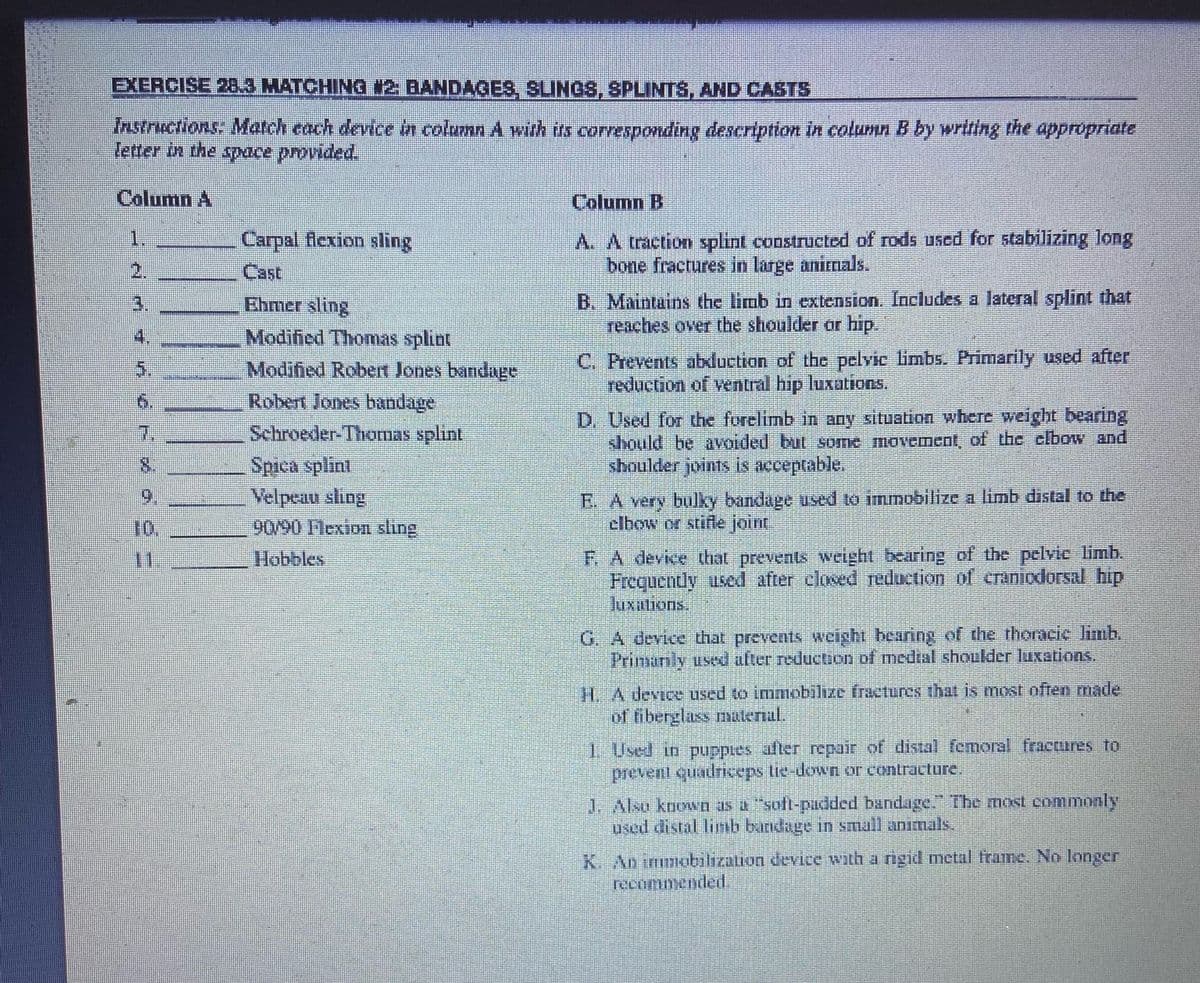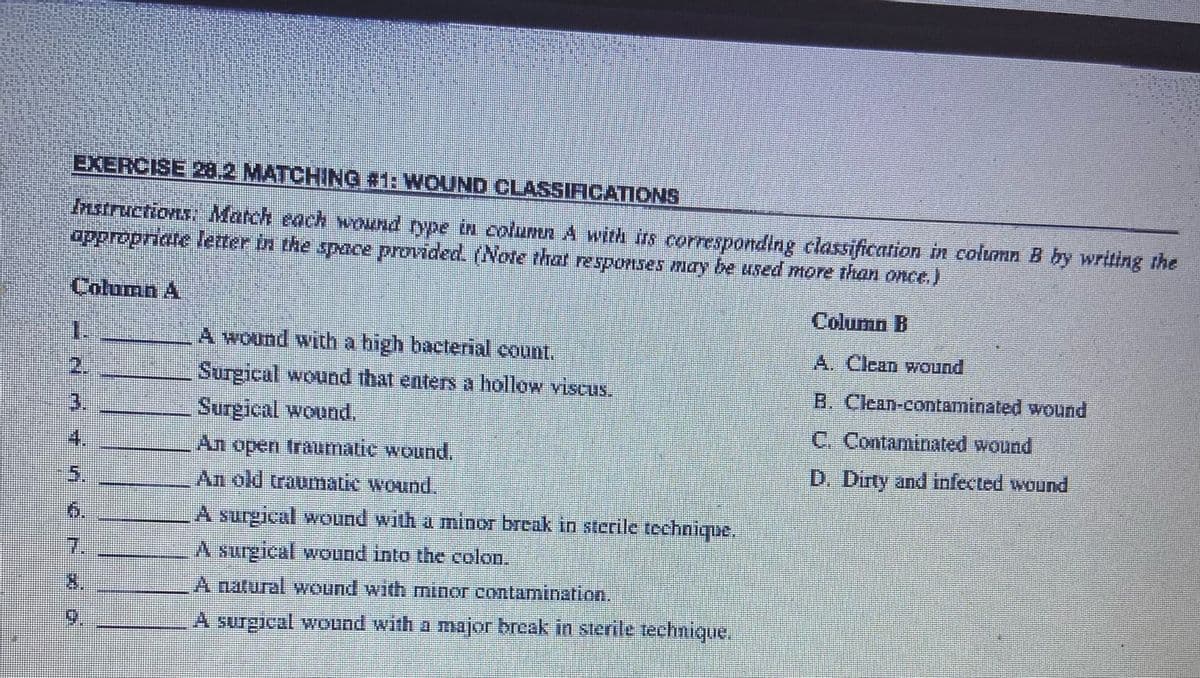EXERCISE 28.3 MATCHING #2: BANDAGES, SLINGS, SPLINTS, AND CASTS Instructions: Match each device in column A with its corresponding description in column B by writing the appropriate letter in the space provided. Column A 1. 4. i vir∞ 7. 8. 9. 10. 11. Carpal flexion sling Cast Ehmer sling Modified Thomas splint Modified Robert Jones bandage Robert Jones bandage Schroeder-Thomas splint Spica splint Velpeau sling 90/90 Flexion sling Hobbles Column B A. A traction splint constructed of rods used for stabilizing long bone fractures in large animals. B. Maintains the limb in extension. Includes a lateral splint that reaches over the shoulder or hip. C. Prevents abduction of the pelvic limbs. Primarily used after reduction of ventral hip luxations. D. Used for the forelimb in any situation where weight bearing should be avoided but some movement, of the elbow and shoulder joints is acceptable. E. A very bulky bandage used to immobilize a limb distal to the elbow or stifle joint F. A device that prevents weight bearing of the pelvic limb. Frequently used after closed reduction of craniodorsal hip luxations. G. A device that prevents weight bearing of the thoracic limb. Primarily used after reduction of medial shoulder luxations. H. A device used to immobilize fractures that is most often made of fiberglass material. 1 Used in puppies after repair of distal femoral fractures to prevent quadriceps tie-down or contracture. J. Also known as a "soft-padded bandage. The most commonly used distal limb bandage in small animals. K. An immobilization device with a rigid metal frame. No longer recommended.
EXERCISE 28.3 MATCHING #2: BANDAGES, SLINGS, SPLINTS, AND CASTS Instructions: Match each device in column A with its corresponding description in column B by writing the appropriate letter in the space provided. Column A 1. 4. i vir∞ 7. 8. 9. 10. 11. Carpal flexion sling Cast Ehmer sling Modified Thomas splint Modified Robert Jones bandage Robert Jones bandage Schroeder-Thomas splint Spica splint Velpeau sling 90/90 Flexion sling Hobbles Column B A. A traction splint constructed of rods used for stabilizing long bone fractures in large animals. B. Maintains the limb in extension. Includes a lateral splint that reaches over the shoulder or hip. C. Prevents abduction of the pelvic limbs. Primarily used after reduction of ventral hip luxations. D. Used for the forelimb in any situation where weight bearing should be avoided but some movement, of the elbow and shoulder joints is acceptable. E. A very bulky bandage used to immobilize a limb distal to the elbow or stifle joint F. A device that prevents weight bearing of the pelvic limb. Frequently used after closed reduction of craniodorsal hip luxations. G. A device that prevents weight bearing of the thoracic limb. Primarily used after reduction of medial shoulder luxations. H. A device used to immobilize fractures that is most often made of fiberglass material. 1 Used in puppies after repair of distal femoral fractures to prevent quadriceps tie-down or contracture. J. Also known as a "soft-padded bandage. The most commonly used distal limb bandage in small animals. K. An immobilization device with a rigid metal frame. No longer recommended.
Related questions
Question

Transcribed Image Text:EXERCISE 28,3 MATCHING #2: BANDAGES, SLINGS, SPLINTS, AND CASTS
Instructions: Match each device in column A with its corresponding description in column B by writing the appropriate
letter in the space provided.
Column A
1.
3
8.
9
11
Carpal flexion sling
Cast
Ehmer sling
Modified Thomas splint
Modified Robert Jones bandage
Robert Jones bandage
Schroeder-Thomas splint
Spica splint
Velpeau sling
90/90 Flexion sling
Hobbles
Column B
A. A traction splint constructed of rods used for stabilizing long
bone fractures in large animals.
B. Maintains the limb in extension. Includes a lateral splint that
reaches over the shoulder or hip.
C. Prevents abduction of the pelvic limbs. Primarily used after
reduction of ventral hip luxations.
D. Used for the forelimb in any situation where weight bearing
should be avoided but some movement of the elbow and
shoulder joins is acceptable.
E. A very bulky bandage used to immobilize a limb distal to the
elbow or stifle joint
F. A device that prevents weight bearing of the pelvic limb.
Frequently used after closed reduction of craniodorsal hip
luxations.
G. A device that prevents weight bearing of the thoracic limb.
Primanly used after reduction of medial shoulder luxations.
H. A device used to immobilize fractures that is most often made
of fiberglass material.
1. Used in puppies after repair of distal femoral fractures to
prevent quadriceps tie-down or contracture.
J. Also known as a "soft-padded bandage. The most commonly
used distal limb bandage in small animals.
K. An immobilization device with a rigid metal frame. No longer
recommended

Transcribed Image Text:EXERCISE 28.2 MATCHING #1: WOUND CLASSIFICATIONS
Instructions: Match each wound type in column A with its corresponding classification in column B by writing the
appropriate letter in the space provided. (Note that responses may be used more than once.)
Column A
Column B
A. Clean wound
B. Clean-contaminated wound
C. Contaminated wound
D. Dirty and infected wound
1.
NAÍŇér í o
5.
A wound with a high bacterial count.
Surgical wound that enters a hollow viscus.
Surgical wound.
An open traumatic wound.
An old traumatic wound.
A surgical wound with a minor break in sterile technique.
A surgical wound into the colon.
A natural wound with minor contamination.
A surgical wound with a major break in sterile technique.
Expert Solution
This question has been solved!
Explore an expertly crafted, step-by-step solution for a thorough understanding of key concepts.
This is a popular solution!
Trending now
This is a popular solution!
Step by step
Solved in 3 steps
